There are few here who can spur Singaporeans into immediate action the way parking attendants do.
Sometimes known also as "summon aunties" (and mostly pronounced "sah-mahn"), the vaguest sight of them sends drivers scrambling for their vehicles to avoid being fined for a host of parking violations.
It's little wonder, then that parking attendants were labelled as "Parking Pontianaks" by the Dim Sum Dollies.
It is safe to say that the parking attendant is so ingrained into our social consciousness that they've become local icons.
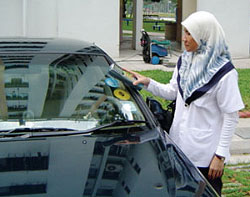 Source: Challenge.gov.sg
Source: Challenge.gov.sg
But how did parking attendants become who they are now in our society?
Jaga Kreta boys: the OG summon aunties & uncles
Before parking attendants came along, there was a group of people known as "jaga kreta" or "car-watching" boys in the 1950s.
These were unemployed males who would hang out around car parks in the city centre and demand payment from motorists who parked there. The fee, usually 50 cents or $1, was a form of bribe or protection money fosr "watching" the vehicles.
Sometimes the jaga kreta boys would be joined by chuchi kreta boys, who would offer to wash the car or wipe its windscreen for a fee.
Unemployment was rife in those days, and for some, becoming a jaga kreta boy was a way to make a living. Even a once-internationally-famous Singaporean boxer who K.O.ed American opponents twice his size in Madison Square Garden became one in his later years.
Here's an article about him:
 Photo via Newspaper.sg
Photo via Newspaper.sg
But the jaga kreta boys were a menace, too — if you didn't pay them their dues, you would risk getting your car vandalised.
As the problems they caused got worse, the Automobile Association of Singapore and Traffic Police took action to get rid of them in 1956 and 1958, respectively.
 Left: Straits Times Feb. 25, 1956, Right: Singapore Free Press Mar. 12, 1958. Source: NewspaperSG
Left: Straits Times Feb. 25, 1956, Right: Singapore Free Press Mar. 12, 1958. Source: NewspaperSG
Bringing order to parking in the city centre
What gave rise to the jaga kreta boys menace in the 1950s was also the indiscriminate parking practices adopted by motorists.
Often, cars would just be parked by the roadside where there were no designated spaces, which allowed the jaga kreta boys to come along and operate their own charging system.
So, to bring order to the parking situation, founding deputy prime minister Toh Chin Chye approved the implementation of a pay-as-you-park scheme in 1959.
It was a turning point in parking history.
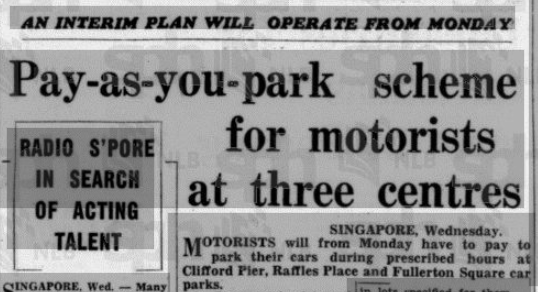 Straits Times on Dec. 19, 1959. Source: NewspaperSG
Straits Times on Dec. 19, 1959. Source: NewspaperSG
Under the scheme, cars parked at designated government-run car parks in the city centre were charged by the hour during prescribed hours.
 Source: NAS
Source: NAS
No jaga kreta or chuchi boys were allowed at these government-run car parks.
The task of running these car parks fell on newly-employed parking attendants in grey uniforms, who would issue tickets on payment of the parking fees.
And these folks became what we know and recognise today as summon aunties.
 Straits Times on Dec. 19, 1959. Source: NewspaperSG
Straits Times on Dec. 19, 1959. Source: NewspaperSG
Jobs for people, money for the government
The pay-as-you-park scheme, along with the deployment of parking attendants, started out as an interim scheme, until parking meters were introduced because the government wanted a Smart Nation then.
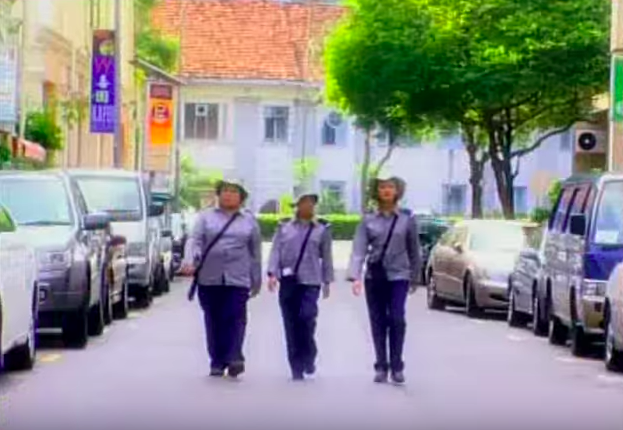 Source: YouTube screenshot
Source: YouTube screenshot
But this scheme never really went away.
One reason for this is it created jobs — remember our bad unemployment problem? Singaporean researcher Azhar Ghani points this out in the an essay for the Lee Kuan Yew School of Public Policy:
"In 1960, the Workers' Brigade was formed with a budget of $7 million as an unemployment relief scheme, to take jobless young people off the streets and give them work in land reclamation, road building and irrigation works. They were paid daily and given food and accommodation. Around the same time, the government had also decided to recruit car park attendants in great numbers to not only help alleviate the unemployment problem, but also to impose order on the parking situation in the city centre."
Back in 1961, Toh pointed this out when he was defending the idea of employing parking attendants, highlighting that the role gave jobs to local boys and girls out of school.
Attendants received free uniforms, shoes, umbrellas, and straw hats, on top of their pay.
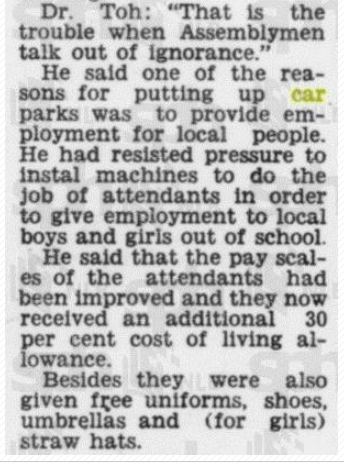 Straits Times on Dec. 11, 1961. Source: NewspaperSG
Straits Times on Dec. 11, 1961. Source: NewspaperSG
In case you're wondering, this is the nice man who fought for the jobs of your favourite summon aunties, which continue to prevail today:
[caption id="" align="aligncenter" width="314"] Toh Chin Chye. Source: Wikipedia[/caption]
Toh Chin Chye. Source: Wikipedia[/caption]
[related_story]
Another big reason the scheme endured: it earned the government good money.
Within its first year alone, Toh revealed that the government made a net profit of $13,000 from the pay-as-you-park scheme — quite a lot of money in 1960 — and so the scheme was expanded to more car parks.
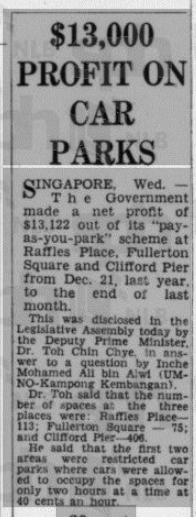 Straits Times on Feb. 11, 1960
Straits Times on Feb. 11, 1960
Already had haters from 1960s
Despite the perks of employment, parking attendants faced multiple challenges.
Like their contemporary counterparts, they, too, faced abuse by errant motorists, like this dude who was fined $20 for slapping a summon auntie, whom he claimed had "abused" him.
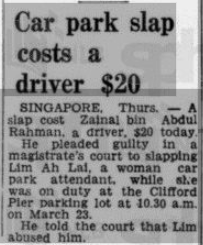 Straits Times on May 10, 1963. Source: NewspaperSG
Straits Times on May 10, 1963. Source: NewspaperSG
Naturally, the jaga kreta boys were unhappy with the loss of their income:
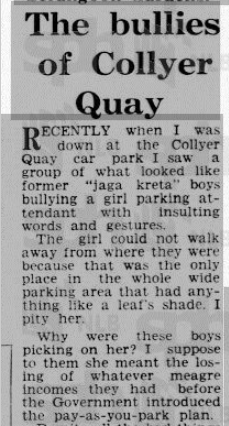 Singapore Free Press on Jun. 3, 1961. Source: NewspaperSG
Singapore Free Press on Jun. 3, 1961. Source: NewspaperSG
But to be fair, there were some errant attendants too.
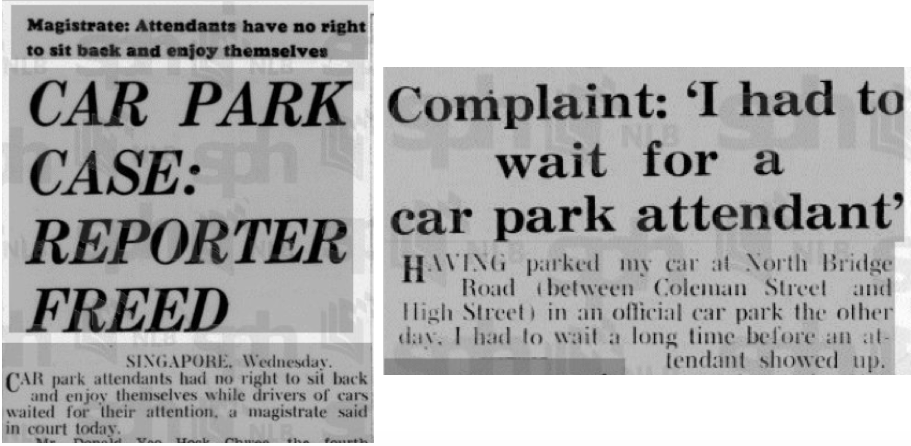 Left: ST on Jun. 24, 1965, Right: Singapore Free Press on Jul. 29, 1961. Source: NewspaperSG
Left: ST on Jun. 24, 1965, Right: Singapore Free Press on Jul. 29, 1961. Source: NewspaperSG
Roles evolved over time
The pay-as-you-park system, in its original form, remained all the way till 1980, when the parking coupon system was implemented.
Under the new system, the role of the parking attendant shifted from one that involved the collection of payments to the more familiar role of enforcement.
[caption id="" align="aligncenter" width="1280"] Image from YouTube[/caption]
Image from YouTube[/caption]
And with the introduction of electronic payments and gantries at almost every HDB carpark these days, there may actually come a day where the job of parking attendant will become a thing of the past.
Top image via YouTube.
If you like what you read, follow us on Facebook, Instagram, Twitter and Telegram to get the latest updates.